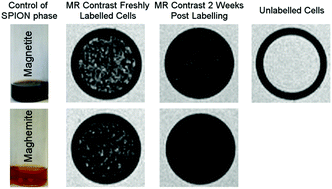当前位置:
X-MOL 学术
›
Biomater. Sci.
›
论文详情
Our official English website, www.x-mol.net, welcomes your
feedback! (Note: you will need to create a separate account there.)
SPIONs for cell labelling and tracking using MRI: magnetite or maghemite?†
Biomaterials Science ( IF 5.8 ) Pub Date : 2017-11-23 00:00:00 , DOI: 10.1039/c7bm00515f Michael Barrow 1 , Arthur Taylor , Ana M Fuentes-Caparrós , Jack Sharkey , Luke M Daniels , Pranab Mandal , B Kevin Park , Patricia Murray , Matthew J Rosseinsky , Dave J Adams
Biomaterials Science ( IF 5.8 ) Pub Date : 2017-11-23 00:00:00 , DOI: 10.1039/c7bm00515f Michael Barrow 1 , Arthur Taylor , Ana M Fuentes-Caparrós , Jack Sharkey , Luke M Daniels , Pranab Mandal , B Kevin Park , Patricia Murray , Matthew J Rosseinsky , Dave J Adams
Affiliation

|
Although there is extensive literature covering the biomedical applications of superparamagnetic iron oxide nanoparticles (SPIONs), the phase of the iron oxide core used is not often taken into account when cell labelling and tracking studies for regenerative medicine are considered. Here, we use a co-precipitation reaction to synthesise particles of both magnetite- (Fe3O4) and maghemite- (γ-Fe2O3) based cores and consider whether the extra synthesis step to make maghemite based particles is advantageous for cell tracking.
中文翻译:

使用 MRI 进行细胞标记和跟踪的 SPION:磁铁矿还是磁赤铁矿?†
尽管有大量文献涉及超顺磁性氧化铁纳米颗粒 (SPION) 的生物医学应用,但在考虑再生医学的细胞标记和跟踪研究时,通常不会考虑所使用的氧化铁核心的相。在这里,我们使用共沉淀反应来合成磁铁矿- (Fe 3 O 4 ) 和磁赤铁矿- (γ-Fe 2 O 3 ) 基核颗粒,并考虑额外的合成步骤来制造磁赤铁矿基颗粒是否有利于细胞追踪。
更新日期:2017-11-23
中文翻译:

使用 MRI 进行细胞标记和跟踪的 SPION:磁铁矿还是磁赤铁矿?†
尽管有大量文献涉及超顺磁性氧化铁纳米颗粒 (SPION) 的生物医学应用,但在考虑再生医学的细胞标记和跟踪研究时,通常不会考虑所使用的氧化铁核心的相。在这里,我们使用共沉淀反应来合成磁铁矿- (Fe 3 O 4 ) 和磁赤铁矿- (γ-Fe 2 O 3 ) 基核颗粒,并考虑额外的合成步骤来制造磁赤铁矿基颗粒是否有利于细胞追踪。











































 京公网安备 11010802027423号
京公网安备 11010802027423号